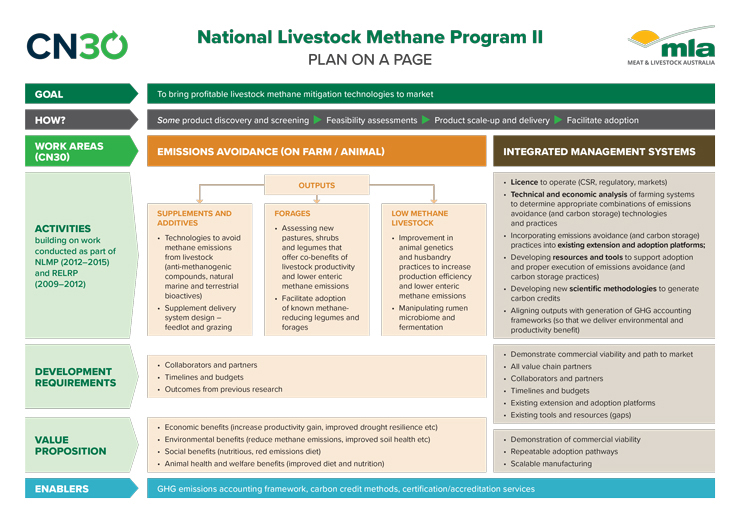Subscribe to MLA's Quarterly Feed e-newsletters
Stay informed with the latest red meat and livestock industry news, events, research and marketing.
National livestock methane program
The National Livestock Methane Program (NLMP) ran from 2012 – 2015 and included foundational, discovery level research to identify technologies that could increase livestock productivity and reduce the production of enteric methane, which is a potent greenhouse gas. The Red Asparagopsis seaweed, which is now being commercialised by CSIRO’s spin-off company Future Feed, is just one of the antimethanogenic technologies that were identified through NLMP research. NLMP built on an earlier program, the Reducing Emissions from Livestock Research Program (RELRP; 2009-2012).
MLA are currently facilitating development of a the National Livestock Methane Program II, to build on outcomes of NLMP and RELRP, but with an increased focus on commercialisation and adoption. The goal of NLMP II is “to bring profitable livestock methane mitigation technologies to market”.
NLMP objectives
- develop practical on-farm options to achieve a significant reduction in methane emissions from livestock
- quantify the level of abatement achievable while at the same time increasing productivity
- provide the science to underpin methodologies developed under the Emission Reduction Fund
NLMP projects
NLMP consisted of five themes, 16 research projects, and one project to develop a database of NLMP findings.
National Livestock Methane Program themes and projects:
- Measuring methane in the rumen under different production systems as a predictor of methane emissions (CSIRO)
- Development of gas selective membranes (for intra-ruminal capsules) (RMIT)
- Evaluation and optimisation of GreenFed Emission Monitoring units for measuring methane emissions from sheep and cattle (UNE)
- Understanding methane reducing tannins in enteric fermentation using grape marc as a model tannin source (AWRI)
- Development of algae-based functional foods for reducing enteric methane emissions from cattle (CSIRO)
- Supplementation with tea saponins and statins to reduce methane emissions from ruminants (CSIRO)
- Practical and sustainable considerations for the mitigation of methane emissions in the northern Australian beef herd using nitrate supplements (Ridley Agriproducts)
- Strategic science to develop dietary nitrate and defaunation as mitigation methodologies for grazing ruminants (UNE)
- Enteric methane mitigation strategies through manipulation of feeding systems for ruminant production in Southern Australia (DEPI Vic)
- Impacts of Leucanea spp. plantations on greenhouse gas emissions and carbon sequestration in Northern Australian cattle production systems (CSIRO)
- Best choice shrub and inter-row species for reducing emissions and emissions intensity (UWA)
- The mechanism of antimethanogenic effects of bioactive plants and products on methane production in the rumen (UWA)
- Efficient Livestock and Low Emissions (ELLE) from southern grazing systems (UWA)
NLMP II
The National Livestock Methane Program II (NLMP II) builds on previous research, particularly research conducted as part of the first NLMP (2012-2015) and the Reducing Emissions from Livestock Research Program (RELRP; 2009-2012).
While NLMP was primarily involved in foundational, discovery level research, NLMP II is much more focused on the adoption and commercialisation stages of technology development.
The consortium of collaborators that will be involved in NLMP II is currently being developed. This page will be updated to include the consortium structure, the funding and research partners, the activities, and the timelines for NLMP II when this information becomes available.
NLMP II plan on a page
Related resources
MLA's tips & Tools: Best management practices for feeding nitrates to cattle



